Disposing of laboratory chemicals responsibly is important for protecting both the environment and public health. Improper disposal can lead to contamination of water sources, soil, and air, posing serious risks to wildlife and humans. Responsible disposal ensures compliance with environmental regulations and promotes sustainability. The best laboratory chemical suppliers in Dubai can provide further guidance on safe disposal practices.
Identify the chemicals:
The first step in responsible chemical disposal is identifying the types of chemicals you are working with. Different chemicals have different disposal requirements depending on their properties, such as flammability, reactivity, toxicity, and biodegradability. Ensure to refer to the safety data sheets (SDS) for each chemical, which provide detailed information on handling, storage, and disposal procedures. This will help determine whether the chemical is hazardous or non-hazardous and what specific precautions must be taken.
Segregate and label waste:
Proper segregation of chemical waste is key. Never mix chemicals unless you are certain they are compatible. Mixing incompatible chemicals can result in dangerous reactions, such as the release of toxic fumes or even explosions. Organize the waste into separate containers, clearly labelled with the chemical names, concentrations, and hazard symbols. This makes it easier to identify the waste and ensures that it is handled appropriately throughout the disposal process. Additionally, use containers that are compatible with the chemicals to prevent leaks or reactions.
Use approved disposal methods:
Each laboratory should follow local and national regulations regarding the disposal of hazardous chemicals. Many chemicals require special handling, such as neutralization, incineration, or disposal at designated waste facilities. Some waste may need to be collected by licensed waste disposal companies equipped to handle hazardous substances. Never dispose of chemicals by pouring them down the drain or throwing them in regular trash. Always use approved disposal methods to ensure safety and compliance with environmental laws.
Maintain records and documentation:
Documenting the disposal process is a key aspect of responsible chemical management. Keep records of the chemicals disposed of, including their quantities, disposal methods, and dates. This documentation is important for maintaining laboratory safety protocols and meeting regulatory requirements. It also helps in tracking any chemical spills or accidents that may occur in the future, ensuring transparency and accountability.
